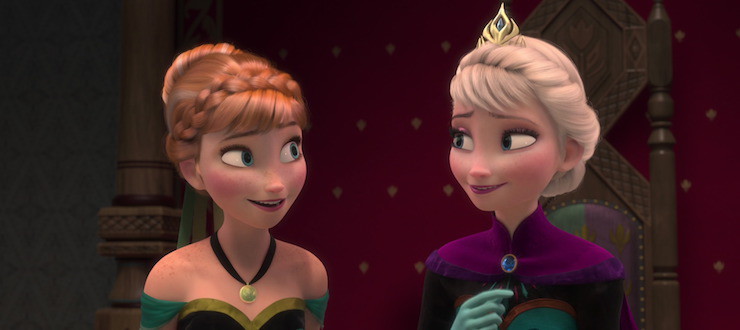According to the expert opinions of the kids next door, Frozen is not just the best Disney movie ever, but the best movie ever ever ever.
EVER.
Which is one reason why I hesitated to include it in this Read-Watch: that expert opinion has also led the kids next door to play the English and Spanish soundtracks from Frozen at high volume on a regular basis, and, far worse, sing along with both. By the fifth rendition of “Do You Wanna Build a Snowman/Si Hacemos un Muñeco” during a Florida August, I was ready to hunt down the songwriters and bury them in snowmen myself. Plus, I had the excuse that Frozen, despite a credit that reads “inspired by” Hans Christian Anderson’s The Snow Queen, departs so far from that novella that the film is usually credited as a Disney original.
So skipping Frozen was the original plan—until, that is, I happened to reread The Snow Queen for other reasons, and realized that, in spirit, Frozen may be probably closer to its original source material than anything we’ve seen so far in this reread.
Really.
Disney animators had thought about adapting The Snow Queen as far back as 1937, when it was suggested, along with several other fairy tales, as a potential follow-up to Snow White and the Seven Dwarfs. In many ways, the story—a small girl heads off to the north to try to save her young friend, Kay, captured by the Snow Queen after his heart was pierced by a shard of evil glass—seemed perfect for a Disney adaptation. The original story even had talking animals and flowers—Disney staples—a few witches, and a prince and princess. It virtually screams “adapt this, Disney.”
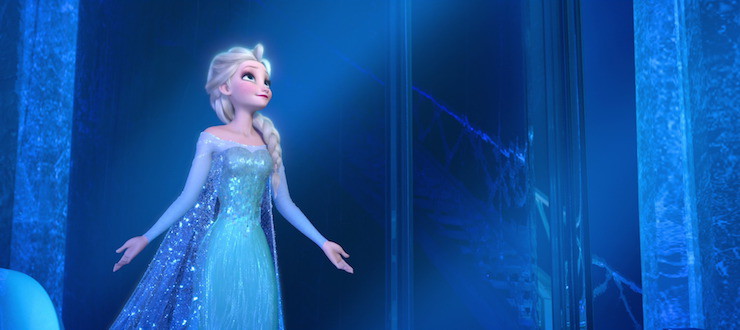
But those screams did little to help Disney adapt the story. Part of the problem—a huge problem—is that the original story arguably has too many villains: the demon who creates the original evil mirror, the witch who briefly enchants and imprisons little Gerda, the robbers, and, of course, the Snow Queen herself. But also arguably, the original story hardly has any villains at all, or at least satisfactory ones. The witch enchants Gerda out of loneliness, not malice; the robbers end up helping little Gerda; and the Snow Queen is less evil and more merely a force of nature. Indeed, at one point the Snow Queen even argues that she’s helping agriculture, and she—arguably—even helps to save Kay, by pulling him away from the dangerous sledding that almost kills him.
Granted, that’s from her viewpoint, and the text rather heavily implicates that the sledding and the snow might indeed have killed Kay, forcing Gerda to not just save Kay, but bring him back from death. But even in that reading, the Snow Queen lacks the malice Disney wanted from its villains. That left only the demon—who vanished at the beginning of the story. And although Disney had been willing to give audiences a glimpse of a demon in Fantasia, the company was not yet willing to feature a demon as the main villain of a full length animated film.
Nor was anyone at Disney particularly interested in using ice as a metaphor for reason, much less focusing on the battle between Love and Reason in the late 1930s and early 1940s. They faced other, more urgent battles. The moment slipped by. By the 1950s, Disney lacked the financial resources to animate the delicate images of ice and snow fairies as they had to such great effect in Fantasia. With no script, and no ability to animate the script, even if they had one, the original concept art was quietly filed away.

Animators took another look at The Snow Queen during the Disney Renaissance of the 1990s, but once again, nobody knew quite what to do with it. Eventually Glen Keane, assigned to take another look at it, decided to focus on the more straightforward Tangled instead. That concept art, too, was filed away, and seen by very few.
Fortunately, one of those few just happened to be John Lasseter, who had become the Chief Creative Officer at Disney Animation in 2006. As he would later tell the media, he loved the original concept art, and ordered animators to take another look at it.
Initially, that look consisted only of the filmmakers finally managing to agree on one thing: the name “Gerda” should be replaced by “Anna.” That was still more progress than anyone had made on the concept for decades, and perhaps encouraged by this one small step—or simply convinced that if he ordered it, it would come—Lasseter ordered animators to continue. By 2011, he was optimistic enough to announce that Frozen would be released in 2013, even though, at that point, the planned film had no script and no solid character designs or background work.
With a looming deadline, animators, directors, and story writers scrambled, and finally, in 2012, cracked open the concept they needed to make The Snow Queen work. They simply wouldn’t do The Snow Queen. Instead, they would change the character of the Snow Queen from villain to victim, and in her own cold way, a hero. And instead of a story focused on rescuing a boy, this would be a story about sisters.
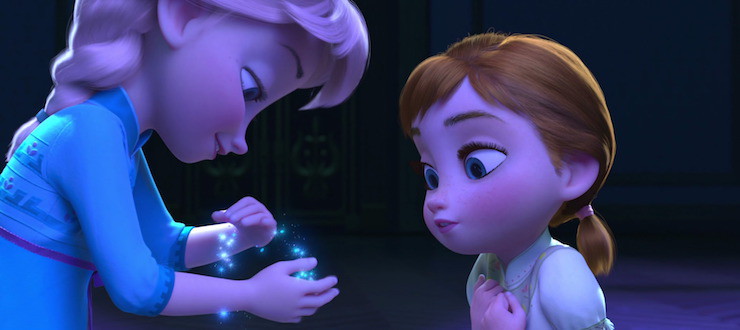
Before Frozen, very few Disney animated films had even had sisters, much less featured them. The short list included the other mermaids in The Little Mermaid, who barely speak; Alice’s older sister in Alice in Wonderland, who also barely speaks; and, more arguably, the stepsisters in Cinderella and the geese in The Aristocats. But Disney had one shining exception to this: Lilo and Stitch, which also just happened to be one of Disney’s few unquestioned post-Disney Renaissance financial successes, and which was still briskly selling merchandise at all of the theme parks and Disney stores. And the all of two Disney animated films featuring friendships between girls of similar ages—Pocahontas and The Princess and the Frog—had at least not been complete box office bombs. Plus, of course, two sisters meant two possible additions to the increasing popular Disney Princess franchise. It was enough to encourage the filmmakers to go ahead with their tale of two sisters.
In any case, the filmmakers, facing that 2013 deadline, did not have time to come up with anything else. They moved on to a new problem: how to get the new story scripted and animated in time for the immutable 2013 release. John Lasseter made one time saving decision for them: after a quick comparison of the box office takes for the hand-animated The Princess and the Frog versus the computer animated Tangled, he tossed the original plans for a lavishly hand-animated film, and instead ordered animators to work with the same process and software used for Tangled. As a nod to this decision, if you pay very very careful attention, you will see the painting that inspired the look of Tangled hanging on the walls of the Arendelle castle.
But although computer animation could be faster, it was hardly a failsafe. Tangled, for instance, had used nice warm sunny backgrounds, while Frozen used snow, something the animators had less experience with. To ensure that the snow looked like real snow, animators made trips to Colorado to look at—and stand in—real snow, and also created a new program, Matterhorn, possibly as a nod to the iconic Disneyland ride, to simulate snow effects. It was arguably used to greatest effect during what would become Frozen’s signature song, “Let It Go,” but can also be seen during the film’s climax out on the frozen lake, as the various characters struggle through wind and snow, as well as in the opening credits.
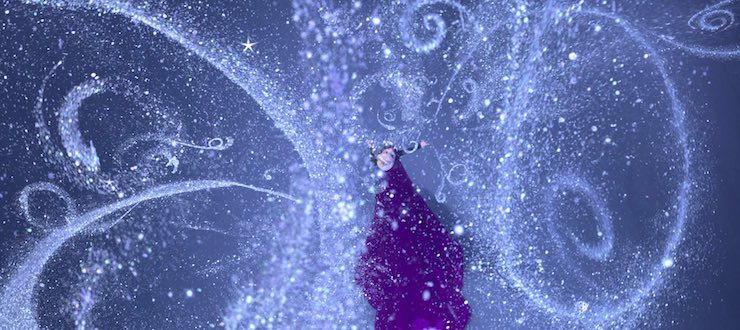
The program helped with both effects and speed. Still, the computer software could only speed things up so much, and with the deadline looming, other things—primarily the script—were rushed, which perhaps explains a few of the film’s problems. Which is to say, no, next door neighbor kids, this film is not flawless.
The biggest, perhaps, is that at times Frozen feels like two different films: the first half, a sung-through musical, and the second half, a cartoon action film. It’s not that either is bad, exactly, especially since and as superficial and sudden as the Anna and Hans romance is, it would be even more superficial and sudden without a song, making the ending even more predictable. Other songs—particularly “Do You Want to Build a Snowman”—allow Frozen to fast forward though several years of plot and character development, while still giving us glimpses of that, to the movie’s improvement. But it does create a bit of a tonal dissonance when the film suddenly flips over to more of an action film.
That dissonance is not at all helped when, in the second half, Frozen DOES suddenly remember that oh, right, it’s supposed to be a musical, and stops to have the little trolls sing about how Anna and Kristoff are both fixer-uppers, which of course means that they’re destined for each other. It’s a cute song, even if it does, perhaps, introduce a few negative things about Kristoff that the audience probably doesn’t need to know (and which never get mentioned before or after this song), and it’s useful for establishing the idea that Kristoff, not Hans, is a better match for Anna romantically, especially since at this point, Hans is still mostly acting heroic.
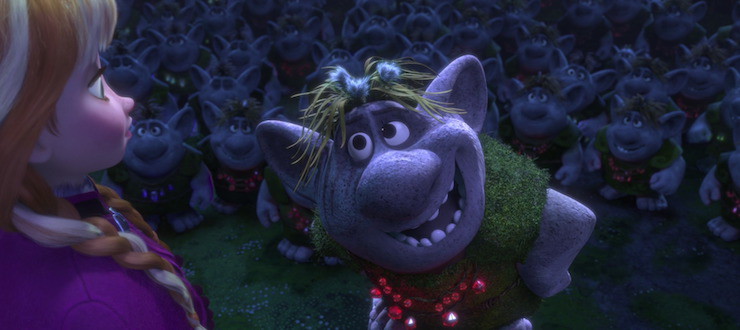
All overshadowed by one big problem: THE KINGDOM IS FREEZING TO DEATH AND ANNA IS DYING WHY ARE ANY OF YOU SINGING ABOUT THIS STUFF RIGHT NOW?
To their credit, both Anna and Kristoff make multiple attempts to stop the song, something else that should be giving the trolls pause, but it’s not enough, and Anna and Kristoff end up in a near fake marriage that mostly serves to waste time. This, I suspect, combined with the terrible advice given by the chief troll early on in the film (more on this in a bit) explains why the trolls never became huge merchandizing successes, in stark contrast to the rest of the film’s characters. When a not very bright snowman, who doesn’t even realize that fire will melt him, manages to be both more focused and wiser than a group of magical stone trolls….well.
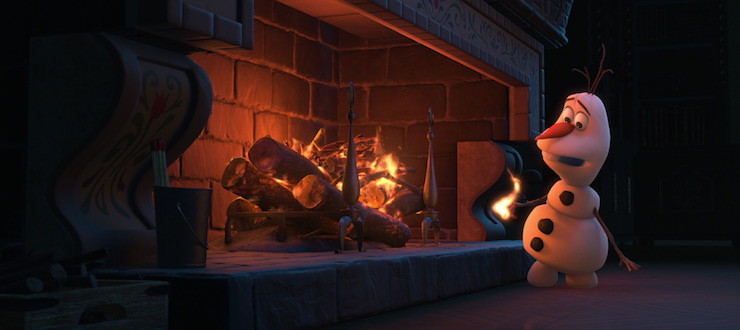
Anyway. I have more problems summoning up any gratitude for Frozen’s second overreaching problem: the many, many, many plot holes in the second half, which go well beyond poor troll timing. Most of these, I suspect, would have been ironed out, if the animators and screenwriters had been given more time. And at least one of the more glaring points—Hans announcing the death of Anna before Anna is, well, dead—can perhaps be handwaved as either a mistake on the part of Hans, or Hans’ awareness that he’s not going to be able to keep this kingdom unless he can kill the woman currently freezing it to death, and since matters keep getting worse on that front, he really doesn’t have any time to waste—and Anna’s death would somewhat justify his attempt to kill Elsa.
Other plot holes are much harder to justify. To pick just one, why, exactly, are the nobles of Arendelle suddenly cheering on Anna when she hits Hans and tosses him off the ship, like, (a) he’s still a foreign prince, Anna, and your sister is already cutting off ties with another international trading partner; do you two want to doom yourselves to permanent trading isolation, and (b) far more importantly, the last time the nobles saw Hans, they were begging him to take over the country and save it. And sure, he tried to kill Elsa—but the last time these nobles saw Elsa, she had frozen over the entire country, freezing ships in the harbor, and destroying several local businesses, and, as far as they knew, attempted to kill her sister. There’s every reason for the audience to hate Hans at this point, of course—they’ve seen him be cruel to poor Anna and leave her for dead—but no reason for the nobles to share those feelings. And, while I’m asking questions about those nobles, exactly why is anyone taking orders or suggestions from the Duke of Weselton? Sure, he’s a major trading partner, but he has even less authority than Hans does—at least Anna gave Hans some verbal authority before she took off.
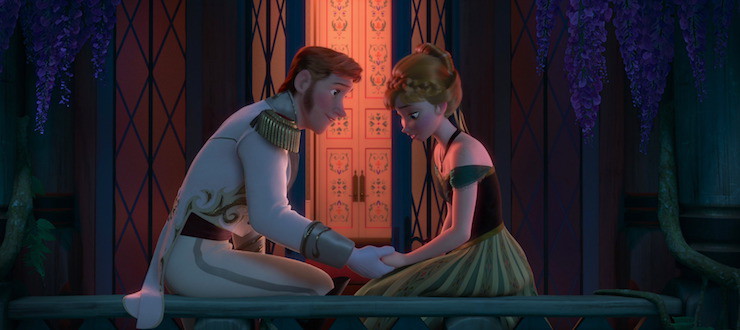
I keep mentioning Hans, in part because his flip from good guy to villain in the film’s last few minutes is another weak point. It’s not that I don’t appreciate what Disney is doing here: it’s a powerful counter to the love at first sight for previous Prince Charmings in earlier Disney films (looking mostly at you, Snow White and Cinderella, although at least Cinderella did get to spend one evening with Prince Bland, which is more than I can say for poor Snow White.) The problem is, apart from attempting to kill a woman who has, let’s remember, frozen the entire kingdom over, proposing marriage to a beautiful princess that he’s only known for about a day, and, well, ok, taking advantage of a sudden power vacuum in Arendelle, Hans honestly doesn’t seem all that bad. And if that list of things does sound awful, I should note that apart from the taking advantage of the sudden power vacuum, this is the exact same list of things done by heroes Prince Philip (who did kill a woman who sent the entire kingdom into darkness, and proposed marriage to a beautiful princess that he’d only known for a few minutes) and Prince Eric (who did help kill a woman seconds after dumping her at the altar and did propose marriage to two beautiful princesses that he’d only known for a few days) did in previous films. Sure, the audience knows that Elsa, unlike Maleficent and Ursula, is fundamentally a good person who doesn’t want to hurt anyone, but the characters only know that after shutting herself up away from people for years, Elsa turned the entire kingdom into ice.
And to give Hans some small credit, he doesn’t try to kill Elsa until nearly the end of the film—in fact, he prevents others from doing so, saving Elsa’s life. Prior to that, he seems to be, well, helpful—not exactly a quality associated with most Disney villains. He’s the first to notice that the fjord has frozen over, for instance. He opens up the castle to freezing town residents, passing out soup and blankets.
And I have to give him full credit for being the only character in the film to recognize how desperately lonely Anna is. Sure, he uses that knowledge to exploit her, but he also provides Anna with some needed emotional and pragmatic support, standing behind her when she decides to head after Elsa, over the objections of other characters. Without that support, Anna might not have been able to go. (Although maybe you should have insisted she bring more supplies along, Hans. Yay for the support, minus several points for not packing her a sandwich.) Is he doing this mostly to take over Arendelle? Maybe, but to his credit, he seems to have no thought of doing this until after Elsa has created a snow monster, and Arendelle’s nobles beg him to take over. Before that, he’s the first—and until Olaf the snowman shows up, about the only—character to show appreciation for the teenage Anna. And he’s hardly the only one to fall for Anna in the space of a few hours—Kristoff does as well.
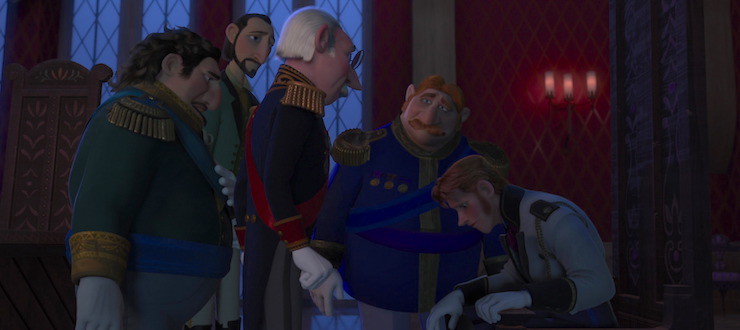
Which is why, in many ways, I find myself wishing that Frozen had taken the time to tweak Hans just a little. By all means keep him as the desperate social climber, but perhaps make his acknowledgement that he’s not in love with Anna less evil, and more regretful. Have him believe that yes, Elsa has to be killed in order to save the kingdom, instead of in order to let him take over the kingdom. Same plot, but just a tinge more complexity.
Instead, Frozen chose to give that complexity to Elsa, the innocent monster.
I say “monster” even though Elsa is beautiful, and becomes even more so in her grand number “Let It Go,” when she embraces her powers, she and those who see her powers—except for Anna and, to a lesser extent, Hans and Olaf—believe the powers, at least, are monstrous. Elsa can kill. She tries not to, but she can, and she accidentally badly injured her little sister and playmate. Accidentally injuring a younger sibling because you were goofing off and not following the rules is not that unusual (this blogger says, somewhat guiltily, while also pointing out that her brother was totally asking for it); injuring a sibling magically is something different.
And so, Elsa’s parents, with the best intentions in the world, try to isolate her. Partly to prevent her from harming others. Partly—as “Let It Go” confirms—to ensure that Elsa won’t be targeted and killed for her powers—something earlier Disney films had established as an all too probable fate, and something that does happen in Frozen, once Elsa’s powers are revealed. By keeping Elsa isolated, and by training her to hide her powers, her parents reason, she’ll be safe: no one will ever guess that she isn’t perfectly normal.
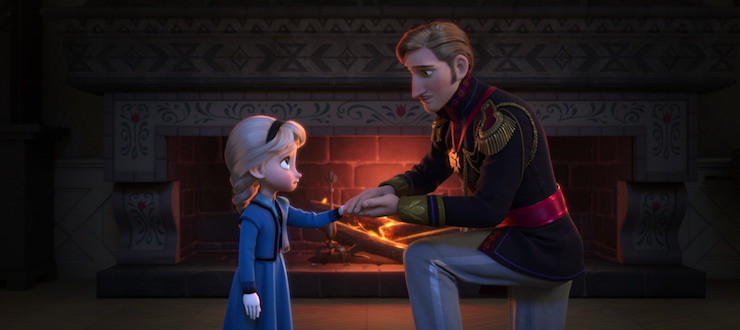
This can be, and has been, read as a metaphor for special needs children, or more precisely, what not to do with special needs children. That’s a subject far too complicated for this post, but for now, I’ll just note that this plan goes spectacularly badly. Because all the secrecy, not surprisingly, leads the countries around Arendelle to assume that Arendelle must be hiding something dreadful. It fills Elsa with self-doubt. And it leaves Anna lonely and vulnerable to anyone able to see this, and willing to say a few friendly words to her. Anna is pretty; it’s not hard for Hans to say those words. It’s a strong argument against isolating children for whatever reason.
Indeed, most of the film is an argument against listening to, or even using, reason.
It’s reasonable for Elsa’s parents to want to protect her and to ensure that she won’t accidentally harm any of Arendelle’s subjects. Kristoff and Anna reason that if an act of true love can save her, she can be saved by a kiss from Hans, the prince she believes she loves. Anna and Olaf later reason that Kristoff must be in love with Anna—otherwise, he wouldn’t be doing any of what he’s doing—and reason that a kiss from Kristoff might save her.
And yet almost all of this reasoning—except for the bit about Kristoff falling for Anna—turns out to be completely wrong.
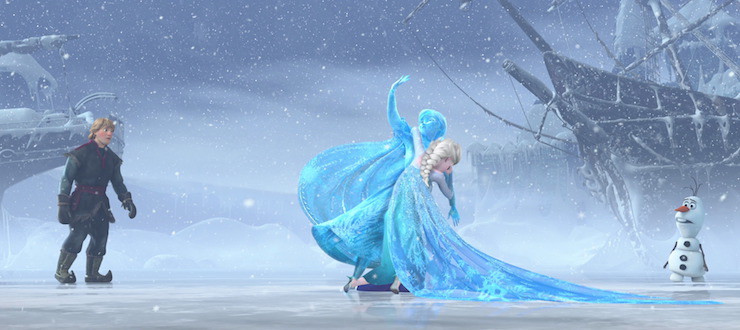
What does end up saving Elsa? Not reason, not control, but a sacrificial act of true feeling. What saves Elsa, in the end, is not reason, but love.
And that, to come back to the earlier point of this post, is why Frozen, in its heart, so closely resembles the original novella. Because above all, The Snow Queen is a novella about the dangers of reason, and the triumph of love. Reason nearly kills little Kay and Elsa and Anna and Arendelle. Love saves them.
This was hardly the first time a Disney film had used this message, of course. But Frozen added one more touch to it, something that, I think, was responsible for the film’s wild success: love also allows Elsa not just to accept, but to control her power. Frozen isn’t just a film about the conflicting power of reason and love, but also a film of self-empowerment.
We’ll just try to skip over the implication that self-empowerment means abandoning reason.
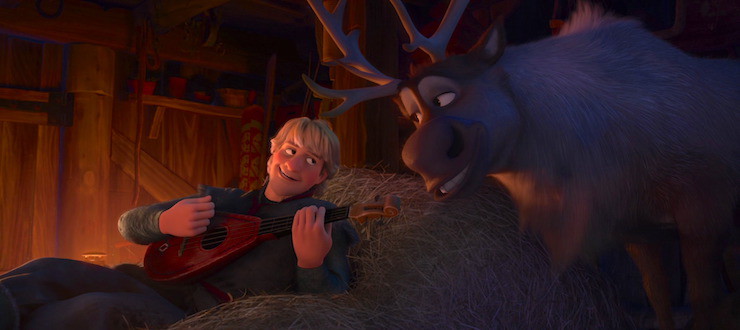
I realize I’ve barely said anything about Kristoff here, but, well, there’s not much to say: he’s cute, his best friend is a reindeer, he has the sense not to ask Anna to marry him immediately, I’m sure he’ll be a great ice transporter/princely consort, and it’ll probably be good for the kingdom to have some decidedly working class blood mingled in with the noble line. I also haven’t said much about Olaf the Snowman, though there’s quite a bit to say: designed as a toy, he is not quite as annoying as he could be, and he has one of the sweetest lines of the film, when he tells Anna that some people are worth melting for. Also, as it turns out, his plush toy version makes for a great weapon against a younger sibling.
The story development was rushed; the animation was rushed; and co-director Jennifer Lee ended up having to drag her own daughter in to voice the lines for nine year old Anna. And yet, Frozen was a wild success, becoming only the second animated film in history, after Toy Story 3, to break $1 billion at the worldwide box office. (It has since been joined in that rare category by Zootopia and Universal’s Minions.) It remains, as of this writing, the all time top grossing animated film not adjusted for inflation after only one release. Frozen also stood up well against live action features: it is, after Avatar and Titanic, the highest grossing original film of all time, and until 2015 was one of the top ten grossing films of all time, live action and animated. Part of the international success may have stemmed from Disney’s decision to have Frozen translated and dubbed into 41 languages, including two separate Spanish versions, but Frozen also enjoyed a strong domestic release.
(Adjusted for inflation, several Disney films top it, including Snow White and the Seven Dwarfs, Cinderella, The Jungle Book, and The Lion King, though those films have also benefited from having multiple releases. So far, Frozen has only had two: the initial release and a later sing along version.)
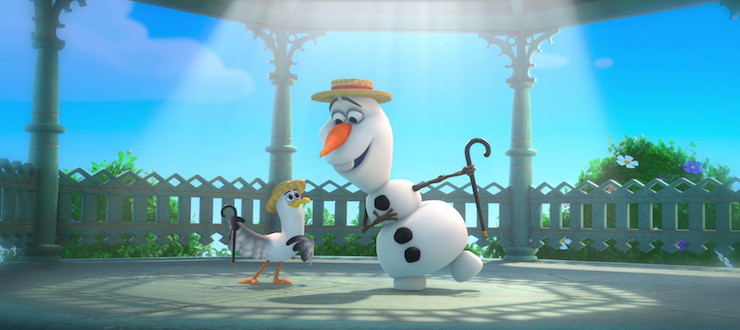
And that was just at the box office. Frozen merchandise soon became the most popular items in Disney stores. The demand caught executives, expecting Tangled sales levels, by surprise. Shoppers soon found that Frozen merchandise, and in particular Elsa merchandise, sold out. Disney ended up having to issue an official apology for underestimating demand. Disney rapidly scrapped plans for adding Elsa and Anna to the Disney Princess franchise, and instead decided to keep the two in their own, separate, and reportedly highly profitable Frozen franchise instead.
By the middle of 2014, Disney CEO Bob Iger told shareholders that Frozen was probably among their top five franchises. Lines to meet and greet Elsa and Anna grew so long that the Magic Kingdom broke down and installed a Fast Pass system to control demand—the only Fast Pass system for Meet and Greets outside of Star Wars weekends over at Hollywood Studios. The popular Maelstrom ride at Epcot was retrofitted to become a new Frozen ride—after park engineers figured out a way to squeeze the expected even longer lines into the Norway pavilion and set up a new, larger meet and greet section. (The government of Norway stopped funding the pavilion years before Frozen was released, but it’s highly possible that Disney would have decided to risk losing that funding and capitalizing on Frozen’s popularity in any case.) Disney began developing a Broadway show, and—of course—an ice skating show. Forbes has estimated that ancillary revenue from Frozen may be well over 20 times the box office take, and the film continues to enjoy steady DVD and Blu-Ray sales.
Meanwhile, Disney animators were working on their next project—something that could make use of one of Disney’s other popular franchises, Marvel Entertainment. They had found, they thought, something that could stand apart from the other Marvel films.
Next up: the last post in the Read-Watch: Big Hero 6.
Mari Ness lives in central Florida.










